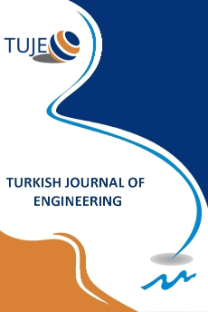DEVELOPMENT OF A NEW APPROACH TO MEMBRANE BIOREACTOR TECHNOLOGY: ENHANCED QUORUM QUENCHING ACTIVITY
DEVELOPMENT OF A NEW APPROACH TO MEMBRANE BIOREACTOR TECHNOLOGY: ENHANCED QUORUM QUENCHING ACTIVITY
___
- Ahmed Z, Cho J, Lim BR, Song KG, Ahn KH. (2007) “Effects of sludge retention time on membrane fouling and microbial community structure in a membrane bioreactor”. Journal of membrane science. Jan 15; 287(2):211-8.
- Barrios AF, Zuo R, Hashimoto Y, Yang L, Bentley WE, Wood TK. (2006) “Autoinducer 2 controls biofilm formation in Escherichia coli through a novel motility quorum-sensing regulator (MqsR, B3022)”. Journal of bacteriology. Jan 1;188(1):305-16.
- Cheong WS, Kim SR, Oh HS, Lee SH, Yeon KM, Lee CH, Lee JK. Design of quorum quenching microbial vessel to enhance cell viability for biofouling control in membrane bioreactor. J. Microbiol. Biotechnol. 2014 Jan 1;24(1):97-105.
- Dong YH, Zhang LH. (2005) “Quorum sensing and quorum-quenching enzymes”. The Journal of Microbiology. Feb;43(1):101-9.
- Drews A. (2010) “Membrane fouling in membrane bioreactors—characterisation, contradictions, cause and cures”. Journal of membrane science. Nov 1;363(1-2):1- 28.
- Dvořák L, Gómez M, Dvořáková M, Růžičková I, Wanner J. (2011) “The impact of different operating conditions on membrane fouling and EPS production”. Bioresource technology. Jul 1;102(13):6870-5.
- Ergön-Can T, Köse-Mutlu B, Koyuncu İ, Lee CH. (2017) “Biofouling control based on bacterial quorum quenching with a new application: rotary microbial carrier frame”. Journal of membrane science. Mar 1;525:116-24.
- Ergön‐Can T, Köseoğlu‐İmer DY, Algur ÖF, Koyuncu İ. (2016) “Effect of different nanomaterials on the metabolic activity and bacterial flora of activated sludge medium”. CLEAN–Soil, Air, Water. Nov;44(11):1508- 15.
- Hammer BK, Bassler BL. (2003) “Quorum sensing controls biofilm formation in Vibrio cholerae”. Molecular microbiology. Oct;50(1):101-4.
- Jahangir D, Oh HS, Kim SR, Park PK, Lee CH, Lee JK. (2012) “Specific location of enca.psulated quorum quenching bacteria for biofouling control in an external submerged membrane bioreactor”. Journal of membrane science. Sep 1;411:130-6.
- Kawaguchi T, Chen YP, Norman RS, Decho AW. (2008) “Rapid screening of quorum-sensing signal Nacyl homoserine lactones by an in vitro cell-free assay”. Applied Environmental Microbiology. Jun 15;74(12):3667-71.
- Kim SR, Oh HS, Jo SJ, Yeon KM, Lee CH, Lim DJ, Lee CH, Lee JK. (2013) “Biofouling control with beadentrapped quorum quenching bacteria in membrane bioreactors: physical and biological effects”. Environmental science & technology. Jan 4;47(2):836- 42.
- Koseoglu-Imer DY, Kose B, Altinbas M, Koyuncu I. (2013) “The production of polysulfone (PS) membrane with silver nanoparticles (AgNP): physical properties, filtration performances, and biofouling resistances of membranes”. Journal of membrane science. Feb 1;428:620-8.
- Köse-Mutlu B, Ergön-Can T, Koyuncu İ, Lee CH. (2016) “Quorum quenching MBR operations for biofouling control under different operation conditions and using different immobilization media”. Desalination and Water Treatment. Aug 14;57(38):17696-706.
- Lade H, Paul D, Kweon JH. (2014) “Quorum quenching mediated approaches for control of membrane biofouling”. International Journal of Biological Sciences. 10(5):550.
- Metcalf & Eddy B, (1980). “Wastewater engineering: Treatment disposal reuse.” Central Book Company. New york, USA.
- Oh HS, Yeon KM, Yang CS, Kim SR, Lee CH, Park SY, Han JY, Lee JK. (2012) “Control of membrane biofouling in MBR for wastewater treatment by quorum quenching bacteria encapsulated in microporous membrane”. Environmental science & technology. Apr 11;46(9):4877-84.
- Park SY, Lee SJ, Oh TK, Oh JW, Koo BT, Yum DY, Lee JK. (2003) “AhlD, an N-acylhomoserine lactonase in Arthrobacter sp., and predicted homologues in other bacteria”. Microbiology. Jun 1;149(6):1541-50.
- Rahimi Z, Zinatizadeh AA, Zinadini S. (2015) “Preparation of high antibiofouling amino functionalized MWCNTs/PES nanocomposite ultrafiltration membrane for application in membrane bioreactor”. Journal of Industrial and Engineering Chemistry. Sep 25;29:366- 74.
- Wagner VE, Bushnell D, Passador L, Brooks AI, Iglewski BH. (2003) “Microarray analysis of Pseudomonas aeruginosa quorum-sensing regulons: effects of growth phase and environment”. Journal of bacteriology. Apr 1;185(7):2080-95.
- Wu B, Fane AG. (2012) “Microbial relevant fouling in membrane bioreactors: influencing factors, characterization, and fouling control”. Membranes. Aug 15;2(3):565-84.
- Wu B, Yi S, Fane AG. (2011) “Microbial community developments and biomass characteristics in membrane bioreactors under different organic loadings”. Bioresource technology. Jul 1;102(13):6808-14.
- Yeon KM, Cheong WS, Oh HS, Lee WN, Hwang BK, Lee CH, Beyenal H, Lewandowski Z. (2008) “Quorum sensing: a new biofouling control paradigm in a membrane bioreactor for advanced wastewater treatment”. Environmental science & technology. Dec 18;43(2):380-5.
- Yeon KM, Lee CH, Kim J. (2009) “Magnetic enzyme carrier for effective biofouling control in the membrane bioreactor based on enzymatic quorum quenching”. Environmental science & technology. Sep 2;43(19):7403-9.
- ISSN: 2587-1366
- Yayın Aralığı: 4
- Başlangıç: 2017
- Yayıncı: Mersin Uüniversitesi
WASTE MINERAL OILS RE-REFINING WITH PHYSICOCHEMICAL METHODS
A NEW METHOD FOR THE MEASUREMENT OF SOFT MATERIAL THICKNESS
Mustafa Tahsin Guler, smail Bilican
DEVELOPMENT OF A NEW APPROACH TO MEMBRANE BIOREACTOR TECHNOLOGY: ENHANCED QUORUM QUENCHING ACTIVITY
İsmail Koyuncu, Tülay Ergön Can, Börte Köse Mutlu, Meltem AĞTAŞ, Chung Hak Lee
HACER SİBEL KARAPINAR, Fevzi KILIÇEL
Abdülkerim İLGÜN, Ahmad Javid ZİA
MUSTAFA TAHSİN GÜLER, İSMAİL BİLİCAN
Tülay ERGÖN CAN, Börte KÖSE MUTLU, Meltem AĞTAŞ, Chung Hak LEE, İSMAİL KOYUNCU
